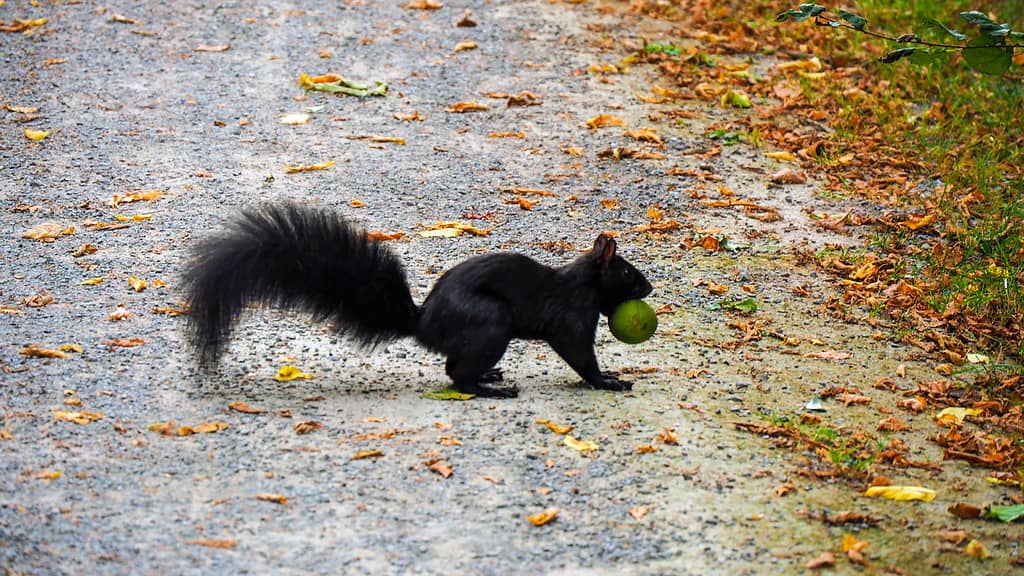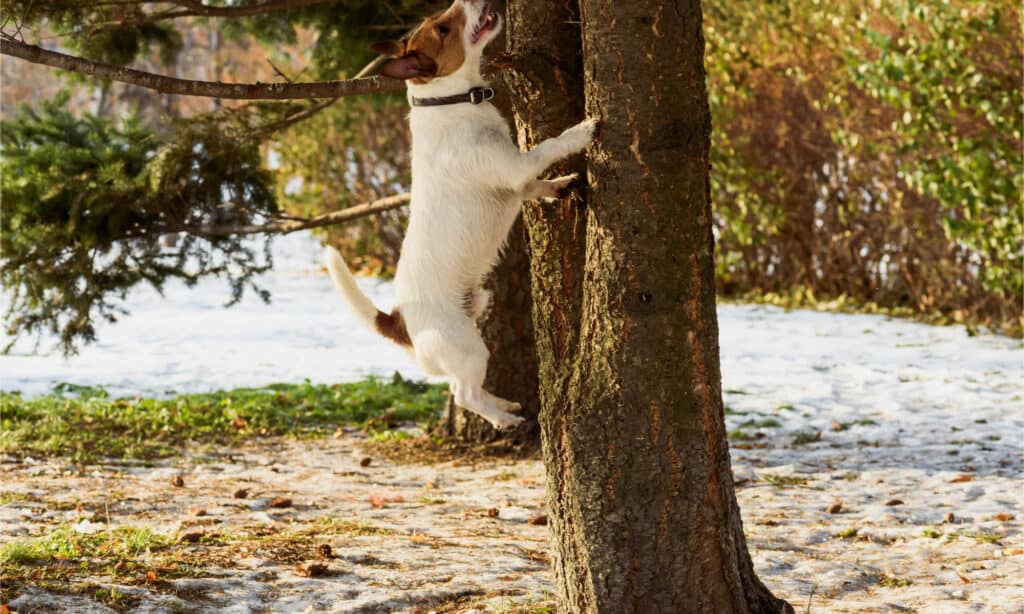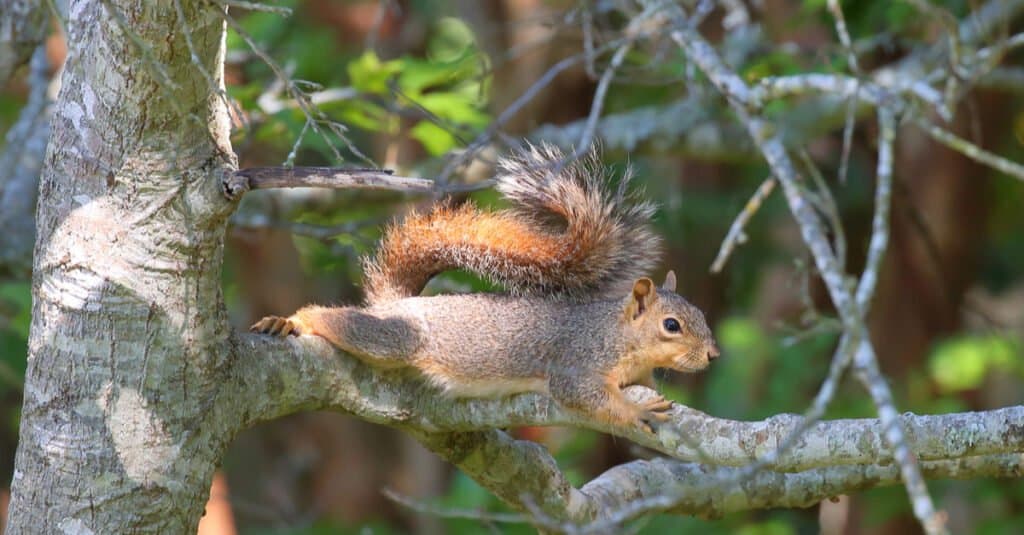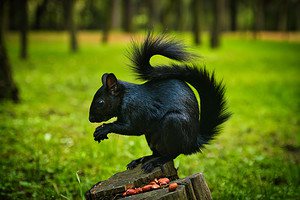Around 41 million squirrels are killed by drivers every year. This is an upsetting experience for many motorists who would prefer to avoid killing wildlife when they get behind the wheel. No matter how carefully you are driving, it is sometimes impossible to avoid these small rodents if they insist on jumping out in front of your car. Squirrels are found all over the world in forests and woodlands. However, they are also found in suburban areas and urban parks and this means that they are close to highways! There are more than 200 species of squirrels including the Eastern gray squirrel and Western gray squirrels which are among the most abundant species of squirrels in North America.
Why Do Squirrels Jump Out in Front of Cars?
Squirrels jump out in front of cars because they use random movements to avoid attacks from predators above (raptor birds) and on the ground. Once a predator has committed to a strike, they find it very hard to change direction. By zigzagging, the squirrel can avoid being caught, and freezing on the spot is part of their tactics. Squirrels may view cars as predators and try zigzagging to stay safe.
In evolutionary terms, vehicles have not been around for that long and so squirrels have not adapted their behavior to stay safe on the roads yet. Habitat loss may also result in squirrels having to cross roads more frequently to find shelter and food.
Why Do Squirrels Freeze in the Middle of the Road?
Running out in front of cars would not be such a problem for squirrels if they kept going! The issue is that some of them run and then stop. This is because they use tactics that can be called ‘stop, dodge, and dart’. By stopping, squirrels confuse the predator particularly if they are not as nimble as the squirrel is. Then, they dart away and escape. This is a fantastic tactic if you are being chased by a fox but doesn’t work when you are trying to cross a busy highway.
When Are Squirrels Hit Most Often?

Squirrels are most active in the fall as they collect food.
©Saeedatun/Shutterstock.com
It’s no surprise that most squirrels are killed on the roads at the time of year when they are most active. This is during the fall when they are going around collecting food for the winter and looking for places to hide it.
Also, baby squirrels are born during the spring but by autumn they are old enough to emerge on their own and some of them don’t have great road sense.
Squirrels are most active at dawn and dusk so this is when most of them are killed on the roads. Very few squirrels are on the road at nighttime because they are diurnal. Therefore, you should be particularly aware that squirrels could be on the road when the sun is rising and setting. Sadly, this often coincides with peak volumes of traffic on the roads.
What Should You Do if a Squirrel Runs in Front of Your Car?
You should never swerve to avoid a squirrel. This is because you could cause an accident and cause a human to be seriously injured or worse. You are also unlikely to miss the squirrel because you could swerve to avoid them and then they could suddenly zigzag directly into your path. The official advice is that you should just keep driving and hit the squirrel. It is also dangerous to slam on the brakes because a car behind you could rear-end you.
How Can You Avoid Hitting a Squirrel on the Road?

If you see a squirrel in the road you should not swerve or break hard.
©iStock.com/Jennifer Seeman
The only way to reduce your chances of hitting a squirrel on the road is to practice defensive driving. This is when you drive steadily and remain very alert for any hazards ahead. There is nothing that we can do to control the behavior of squirrels so all that we can do is control our behavior.
Can Squirrels See or Hear the Car Coming?
Squirrels have large eyes positioned towards the top of their head. This gives them a large field of view and allows them to spot predators approaching them. It also allows them to find their food. The disadvantage of this eye position is that it limits their frontal vision and their depth perception. This may interfere with their interpretation of the approach of a car. However, to compensate, they are constantly scanning the environment by bobbing and weaving which allows them to triangulate distances.
Some species of squirrels have better hearing than others. For example, ground squirrels are not that good at telling whether sound is coming from straight ahead or from the side. Relatively little research has been carried out on the range of squirrel hearing. However, it is suggested that they can hear over a greater range than we can but are better at hearing the higher frequencies.
Why Do Squirrels Run Towards Humans?
Scientists refer to a phenomenon called ‘synurbanization’. This is where animals adapt their behavior to live in urban environments. Squirrels have likely become desensitized to the presence of human beings and the objects associated with human beings – including cars. Unfortunately, this results in them spending more time in and around human development where they are more at risk of injury on the roads.
How Long Do Squirrels Normally Live?

Squirrels have several predators including domestic dogs.
©alexei_tm/Shutterstock.com
The lifespan of squirrels varies by species and with the environment where they are living. Most of them live between five and 10 years in the wild. However, ground squirrels live for three years on average. Western grey squirrels live closer to 10 years. In general, squirrels in captivity live longer than those in the wild.
As well as deaths on the road, many squirrels die because they are hunted by predators. Many animals view squirrels as prey including foxes, polecats, hawks, snakes, coyotes, and bobcats. Some of these animals will also eat the bodies of dead squirrels (carrion) on the roadside. Domestic cats will also eat squirrels and many domestic dogs are obsessed by them but are not always that good at catching them!
Why Don’t Squirrels Stay in Trees?
If squirrels stayed in trees they would never get killed on roads! However, they need to leave trees to forage for food. Squirrels such as the gray squirrel eat hard mast, wild berries, and fruits. Because these foods are less plentiful during the winter, squirrels stash them away during the fall. These hiding places are usually on the ground. The squirrels find their food stashes using their sense of smell rather than relying solely on their memory. At the same time, a large portion of their brain is used for spatial memory so they probably do remember some of their hiding places. Their stores of food can be dug up and moved several times to make sure that they are not stolen by another animal.
Are Squirrels Endangered?

The Delmarva Peninsula fox squirrel is no longer endangered.
©JustPixs/Shutterstock.com
Before 2015, the Delmarva Peninsula fox squirrel was an endangered species but was removed by the U.S. Fish and Wildlife Service (FWS). This was a major US conservation success.
Things are not looking so great for the Western gray squirrel. A review carried out by the Washington State Department of Fish and Wildlife has recommended that its status be changed from threatened to endangered. Their numbers have been in decline since the late 19th century. It is thought that habitat loss and fragmentation are key factors in the reduction in their populations. The increased number of wildfires and disease outbreaks amongst the squirrels has not helped. However, highway mortality has been named as another significant factor.
Several steps are being taken to try to support the squirrel populations. This includes working with landowners to protect their habitats. Hopefully, this means that they will not have to resort to crossing roads so often!
The photo featured at the top of this post is © Jan Stria/Shutterstock.com
Thank you for reading! Have some feedback for us? Contact the AZ Animals editorial team.







